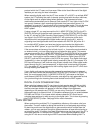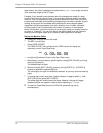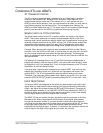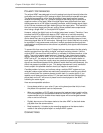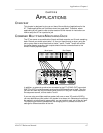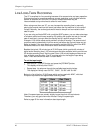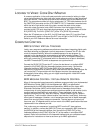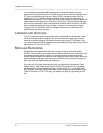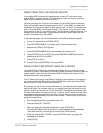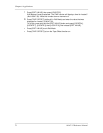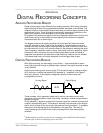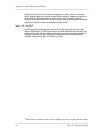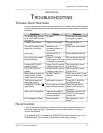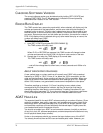
Applications: Chapter 6
ADAT XT Reference Manual 69
LOCKING TO VIDEO: CODE ONLY MASTER
A common application in the audio post-production environment is locking to video
using the timecode on the video tape as a locate reference and the video signal itself
as a clock source. This requires a synchronizer interface, such as the Alesis AI-2 or
BRC. The connections consist of running a balanced 1/4" TRS cable between the AI-
2’s [SMPTE IN] connector and the VTR’s SMPTE OUT (if timecode is recorded onto
either the left or right audio track of the tape, connect the cable to the proper
channel’s output connector) and a BNC connector from the house sync being
provided to the VTR (such as a black-burst generator), or the VTR’s video out to the
AI-2 [VIDEO IN]. The AI-2’s [SYNC OUT] to the XT’s [SYNC IN] connector.
When the XT detects an on-line AI-2, it will ID itself as a slave (ID 1) and the Clock
will automatically switch to External (the EXT icon will light in the CLOCK icon group).
Refer to your AI-2 Reference Manual for more information.
COMPUTER CONTROL
MIDI S
YSTEMS: VIRTUAL TRACKING
Lately, many sequencing software manufacturers have been integrating digital audio
hard disk recording and playback into their sequencers. However, the XT can offer
much of the same flexibility without the added expense of a new program (or
upgrade) or the hardware that accompanies a hard disk recording system. This
requires a timecode interface, such as Steinberg’s ACI or JLCooper’s DataSync 2,
which will convert the XT’s timecode (which is recorded when a tape is formatted)
into MIDI Timecode (MTC) which a sequencer can synchronize to.
Connect the [SYNC OUT] from the XT (or from the last slave in a multiple ADAT
system) to the [SYNC IN] of the timecode interface you are using. Connect the
timecode interface’s [MIDI OUT] to the [MIDI IN] of you sequencer. Set your
sequencer to synchronize to the MTC being received from the timecode interface. As
you control the XT’s tape motion with the transport controls, the sequencer will
automatically follow along, letting you mix digital recordings with virtual MIDI tracks
on a MIDI sequencer.
MIDI MACHINE CONTROL: VIRTUAL REMOTE CONTROL
Many of the computer-based sequencing software programs today have implemented
MIDI Machine Control (MMC) into their sequencers. MMC is a specification
implemented by the MIDI Manufacturers Association (MMA) and the Japan MIDI
Standards Committee (JMSC) which details a set of messages that provide a
universal way of having sequencers and tape machines speak to one another (not to
mention tape machines talking to each other). These messages include: basic
transport functions (like Play, Stop and Record), Locate functions (go to a specific
tape location), Track functions (record-enable, input monitor, track delay), and many
other types of messages. However, not all sequencers send out all these messages;
some even send only basic transport commands. The total amount of control you
have over your XT depends entirely on how much of the MMC specification has been
implemented in the software you use.
First, make sure your sequencer is receiving MTC from the XT (see previous
section). In addition, connect the [MIDI OUT] from your computer’s MIDI interface to
the [MIDI IN] of the timecode interface; then connect the [SYNC OUT] of the
timecode interface to the [SYNC IN] of the XT (of the master in a multiple ADAT
system). Refer to the manuals for the timecode interface and your computer-based
sequencer for instructions on how to set them up for MMC applications.



